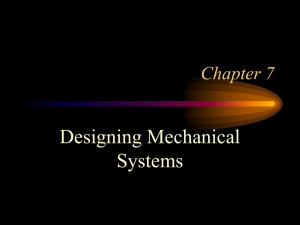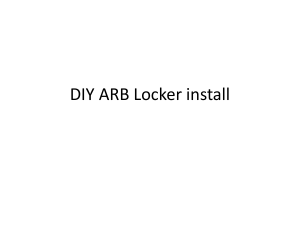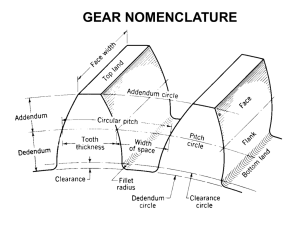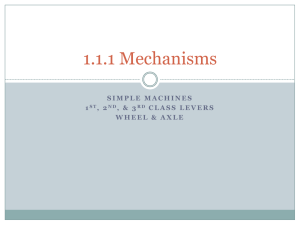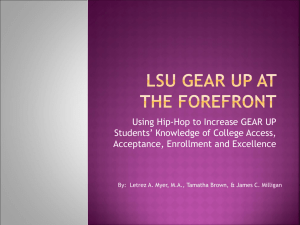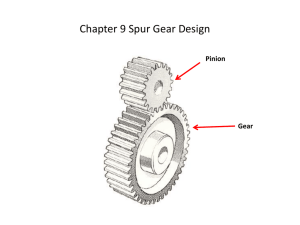Differentials - The Western New York Teacher Center
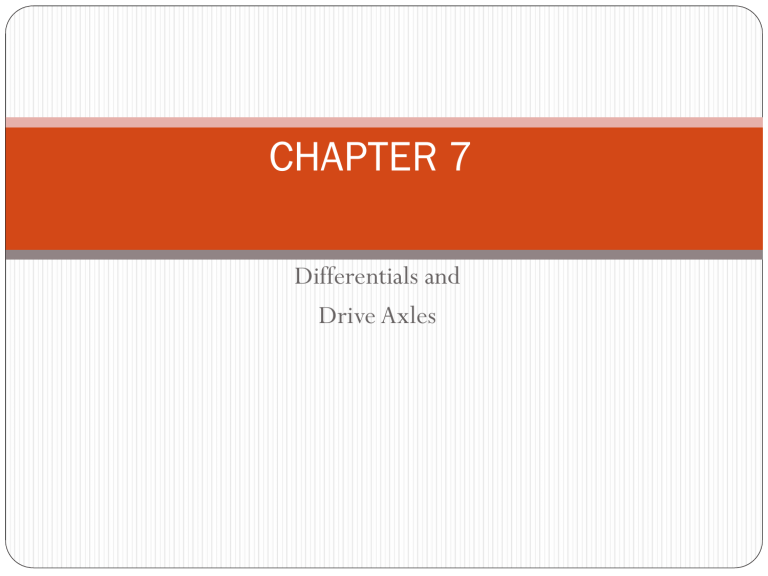
CHAPTER 7
Differentials and
Drive Axles
Purposes of a Drive Axle Assembly
To transmit power from the engine to the wheels
To turn the power flow 90 degrees on RWD cars
To allow the wheels to turn at different speeds while cornering
Allow for final gear reduction
RWD Axle Components
Rear axle housing (single)
Holds all other components and attaches to the vehicle’s suspension
RWD Axle Components
Ring and pinion gears
Provide a final gear reduction
Transfer power
90 degrees to the wheels
RWD Axle Components
Ring and pinion gears
Hypoid Gears
The centerline of the drive pinion gear intersects the ring gear at a point lower than the centerline
They are commonly used in cars and light-duty trucks
Their design allows for a lower vehicle height and more passenger room inside the vehicle
Hyperlink
Spiral Bevel Gears
The centerline of the drive pinion intersects the centerline of the ring gear
They are usually used in heavy-duty truck applications
They are usually noisier than hypoid gears
RWD Live Axle Components (cont’d)
Differential assembly
Contains the differential case which attaches to the ring gear
Includes the side gears and differential pinion gears that allow wheels to turn at different speeds
RWD Live Axle Components (cont’d)
The differential pinion and side gears will always have a thrust washer between themselves and the differential (carrier).
RWD Live Axle Components (cont’d)
Axles
Transmit power from the differential to the wheels
Externally splined at the end to mate with side gear’s internal splines
RWD Live Axle Components (cont’d)
Bearings
pinion (tapered roller) axle (roller) carrier (tapered roller)
FWD Axles
Front wheel drive cars have the engines mounted transversely, thus the powerflow axis is naturally parallel to the drive axles.
Because of this, a simple set of helical gears in the transaxle can serve as the final drive gears
(east/west placement).
RWD Basic Differential Operation
Often referred to as an “open” differential
The pinion gear (small) drives the ring gear (large) which is attached to the carrier housing
RWD Open Differential Operation
When going straight ahead:
The differential housing and its components rotate as a single unit
Each side gear rotates at the same speed
Power is transferred equally to both wheels
Differential Operation
When turning a corner:
The wheels must travel at different speeds to prevent tire scrubbing
Differential Operation
When turning a corner:
Differential pinion gears “walk” around slower side gear and cause other side gear to turn faster
An equal percentage of speed is removed from one axle and given to the other
The amount of torque applied to each wheel remains equal
Differential Operation
If one of the driving wheels has no traction the torque required to turn that wheel is very low.
This causes the pinions to “walk” around the side gear of the axle (wheel) with good traction causing no vehicle movement.
The spinning wheel is actually turning at twice the speed read on the speedometer.
Types of Axle Housings
Live
A one piece housing with tubes extending from each end.
Types of Axle Housings
IRS (Independent Rear Suspension)
The center houses the final drive and differential gears
The axles are external from the housing.
Rear Axle Housings
Integral carrier type
The differential assembly is mounted in and supported by the axle housing
It is sometimes called a Salisbury-type
Types of Axle Housings
Removable carrier type
The differential assembly can be removed from the axle housing as a unit
It is sometimes called a pumpkin-type
Gear Ratios
The overall gear ratio is equal to the ratio of the ring and pinion gears multiplied by the ratio of the gear the transmission is in
Numerically low gears are said to be “high”
Numerically high gears are said to be “low”
Gear ratios are usually selected to provide the best combination of performance and economy
Calculating Overall Gear Ratios
If the transmission gear ratio is:
And the final drive gear ratio is:
The total final drive ratio is: 4.5:1
1.5:1
3:1
1.5 x 3 = 4.5
3 Ways to Determine Final Drive Ratio
Using the vehicle service manual, decipher the code on the tag attached to or stamped on the axle housing
Compare the number of revolutions of the drive wheels with those of the drive shaft
Count the number of teeth on the drive pinion gear and the ring gear
Gearset Classifications
Nonhunting gearset
Each tooth of the pinion gear will come in contact with the same teeth on the ring gear each revolution
The gearset must be assembled with its index marks aligned
An example ratio is 3.0:1
Gearset Classifications
(cont’d)
Partial nonhunting gearset
Any one tooth of the pinion gear will come in contact with some of the teeth on the ring gear each revolution
The gearset must be assembled with its index marks aligned
An example ratio is 3.5:1
Gearset Classifications
(cont’d)
Hunting gearset
Any given tooth on the pinion gear contacts all of the teeth on the ring gear before it meets the same tooth again
The gearset does not have to be indexed
An example ratio is 3.73:1
Transaxle Final Drive Features
The differential operates basically the same as in a RWD axle
There is no 90-degree change in direction
The drive pinion is connected to the transmission output shaft
The ring gear is attached to the differential case
Final Drive Assembly Types
Helical
Requires the centerline of the pinion gear to be aligned with the centerline of the ring gear
Planetary
Allows for a very compact transaxle design
Hypoid
Is quieter and stronger than other designs
Open Differential
When going straight ahead:
The differential housing and its components rotate as a single unit
Each side gear rotates at the same speed
Power is transferred equally to both wheels
Open Differential
When turning a corner:
The wheels must travel at different speeds to prevent tire scrubbing
Differential pinion gears “walk” around slower side gear and cause other side gear to turn faster
An equal percentage of speed is removed from one axle and given to the other
The amount of torque applied to each wheel remains equal
Open differential
Limited-Slip Differentials
Provide more driving force to the wheel with traction when one wheel begins to slip
Still allow the wheels to rotate at different speeds when turning a corner
Are sometimes called Posi-Traction,
Traction-Lok, and Posi-Units
Limited-Slip Differential Designs
Clutch pack type
It uses two sets of clutches, each consisting of steel plates and friction plates
The steel plates are splined to the differential case and the friction plates are splined to the side gears
During cornering, the plates slip, allowing the wheels to turn at different speeds
Limited-Slip Differential Designs
(cont’d)
Cone-type
It uses two cone clutches with one cone that has frictional material on its outer surface and the other with a grooved surface on the inside
Cones allow wheels to turn at different speeds during cornering, while providing torque to both wheels during straight-ahead driving
Limited-Slip Differential
Designs (cont’d)
Viscous clutch-type
It uses steel and frictional clutch plates that rely on the resistance of highviscosity silicone fluid for application
A difference in rotational speed causes the fluid to shear and allows one wheel to turn at a different speed than the other one
Limited-Slip Differential
Gerodisc-type
It uses a clutch pack and a hydraulic pump
The pump is driven by the left axle shaft
The pump’s output determines how much pressure is applied to the clutch pack
The amount of tire slip determines the pressure delivered by the pump
Gerotor pump
Eaton Gerodisc
Limited-Slip Differential - Torsen
Torsen differential (torque sensing) – Designed by
Vernon Gleasman
GM
Audi
Lexus
Peugeot
Toyota
Volkswagen
Limited-Slip Differential - Torsen
When the torque bias ratio (TBR) is less than than 3:1 one wheel can receive up to 75% torque
The other will get 25%
When the TBR is GREATER than 3:1 the worm wheels tighten on the worm gear and the slower side receives torque from the faster side video
Locked Differentials
Very limited differential action, if any
Mostly off-road or race applications
E-Locker – Collar Type
E-Locker Kit
Detroit Locker
Detroit
Locker
Spool Design
No differential operation
Designs of Axle
Bearing Support
Full-floating axle
The bearings are located outside the axle housing
They are usually found on heavy-duty applications
Three-quarter and semi-floating axles
The bearings are located inside the housing
This design is found on passenger cars and light trucks
Types of Axle Bearings
Ball
Is designed to absorb radial and axial end thrust loads
Straight-Roller
Only absorbs radial loads; the axle housing bears the end thrust
Tapered-Roller
Axle end thrust can be adjusted
Independent Rear Suspension
Design Features
The differential is bolted to the chassis
The axles are similar to FWD drive axles
Each axle has an inner and an outer constant velocity joint
Differential Lubrication
Hypoid gear types usually use 75W to 90W gear lube
Limited-slip differentials use special fluid or additive to
Modify clutch plate friction
Ease apply/release of clutches
Some applications require
ATF
Some transaxles use a different lubricant for the transmission and the differential
Noise Definitions
“Chuckle”
A rattling noise that sounds like a stick in the spokes of a bicycle wheel
It is normally heard during coasting
Its frequency will change with vehicle speed
It is usually caused by damaged gear teeth
Noise Definitions
(cont’d)
“Knocking”
Sounds similar to chuckle, but is usually louder
Can occur in all driving phases
Is usually caused by gear tooth damage on the drive side or loose ring gear bolts
Noise Definitions
(cont’d)
“Clunk”
A metallic noise often heard when an automatic transmission is shifted into drive or reverse
May be heard when the throttle is applied or released
Is usually caused by excessive backlash somewhere in the drive line or universal joint play/damage
Noise Definitions
(cont’d)
“Gear Noise”
The howling or whining of a ring gear and pinion
Can occur under various conditions and speeds
Is usually caused by an improperly set gear pattern, gear damage, or improper bearing preload
Noise Definitions
(cont’d)
Bearing “rumble”
Sounds like marbles rolling around in a container
Is usually caused by a faulty wheel bearing
Bearing “whine”
A high-pitched, whistling noise
Is usually caused by faulty pinion bearings
Noise Definitions
(cont’d)
“Chatter”
Can be felt as well as heard
Is usually caused by excessive bearing preload
On limited-slip differentials, it can be caused by using the wrong type of lubricant
Some Causes of Vibrations
Out-of-round or imbalanced tires
Improper drive line angles
Damaged pinion flange
Faulty universal joint
Bent drive pinion shaft
Common Sources of
Axle Assembly Leaks
Damaged pinion seal
Leakage past the threads of the pinion nut
Leakage past the carrier assembly stud nuts
Leaking gaskets
Housing porosity
Defective ABS sensor O-ring
Diagnosing Limited-Slip Concerns
1. Locate the specification for break-away torque
2.With one wheel on the floor and the other one raised, use a torque wrench to check the torque required to turn the wheel
3. If the torque is less than specified, the differential must be checked
Fluid Level Check
Make sure the proper fluid is being used
The vehicle must be level
The axle assembly must be at normal operating temperature
The fluid level should be even with the bottom of the fill plug opening
Measuring Ring Gear Runout
1. Mount a dial indicator on the carrier assembly
2.With the stem of the dial indicator on the ring gear, note the highest and lowest readings
3.The difference between the two readings is the ring gear runout
Carrier Removal and Disassembly
Tips
Always follow shop manual procedures
Mark the alignment of the drive shaft to the pinion flange before disassembly
Check the ring and pinion side play before removing
Keep the shims and bearings in order for reference
Keep the bearings and shims in order for reassembly
Parts Inspection
Clean all parts before inspection
Check the bearings for damage or defects
Check the gears and gear teeth for cracks, scoring, chips, or damage
Reassembly Tips
Always clean the mounting and sealing surfaces before assembly
Always replace ring and pinion gears in sets
Use pilot studs to align the ring gear to the case
Check the gears for timing marks and properly align if necessary (non-hunting)
Replacing a Pinion Seal
1. Check bearing preload before disassembly
Remove the pinion flange
2. Remove the seal using a slide hammer
3. Lubricate the new seal before installation
4. Use a seal driver to install the new seal
5. Follow the manufacturer’s recommendation for tightening the pinion flange nut
Methods Used to Set Pinion
Bearing Preload
Collapsible spacer method
The pinion nut is tightened until the spacer collapses and applies a specific preload to the bearings
Non-collapsible spacer method
Uses selective shims to set the proper preload
Checking Pinion Gear Depth
Check the pinion gear for depth adjustment markings
Use special depth-measuring tools
Follow service manual instructions
Differential Case Adjustments
The differential case can be adjusted side to side to provide proper backlash and side bearing preload
Some designs use threaded bearing adjusters
Some designs use selective shims and spacers for adjustments
Pinion Bearing Preload
Check the pinion bearing preload using an inch-pound torque wrench
Tightening the pinion nut crushes the collapsible spacer to set the preload
Tighten the nut in small increments, checking preload after each phase
Take care not to overtighten the nut
Checking Ring and Pinion Backlash
Mount the dial indicator base firmly on the axle housing
Place the dial indicator against the face of a ring gear tooth
Move the ring gear back and forth and read needle movement
Take readings at several points around the gear
Gear Tooth Pattern
Gear Tooth Pattern
Gear Tooth Pattern
“Drive”—The convex side of the tooth
“Coast”—The concave side of the tooth
“Heel”—The outside diameter of the ring gear
“Toe”—The inside diameter of the ring gear
“High”—The area near the top of the tooth
“Low”—The area near the bottom of the tooth
Gear Tooth Pattern
FWD Final Drive Service
Pinion shaft adjustments are not necessary
Ring gear and side bearing adjustments are necessary
Adjustments are normally made with the differential case assembled and out of the transaxle
Always follow service manual procedures
Clutch Type Limited-Slip Differential
Service
Inspect the clutch plates and side gear retainers for wear and cracks
Refer to the shop manual to determine the proper way to measure thickness
After assembly, check the total width of the clutch pack to determine shim thickness
Tips for Removing Axle Bearings
Never use a torch to remove a retaining ring
Use a drill or cold chisel to loosen a press fit ring
Use a puller to remove a bearing from an axle housing
Use a press to remove a tapered bearing from an axle shaft
Summary
The axle assembly includes the axle housing, ring and pinion gears, differential assembly, and the axles
The two major designs of axle assemblies are the integral and the removable carrier types
A differential allows one wheel to rotate faster than the other in a turn
A limited-slip differential allows torque to be applied to the wheel with the most traction while still allowing the wheels to turn at different speeds while cornering
Differential measurements include pinion depth, pinion bearing preload, backlash, ring gear run-out, and side bearing preload
